
“I knew with a little time he would succeed.”
Jiffy lights it up
Davies, who is widely known as “Jiffy”, was a young star of Welsh rugby in the 1980s, and captained Wales before switching codes and moving to rugby league in 1989.

Welsh import Jonathan Davies in Belmore Oval tunnel in 1991.Credit: Palani Mohan/Fairfax Media
With echoes of Suaalii’s rise - albeit in reverse - Davies had been a sleight and exciting outside back who won man-of-the-match in his Test debut against England in 1985 and had a bright spotlight trained on him from a young age. And a rival code knocking on his door.
“I played in a World sevens tournament in Sydney in 1986 and I scored a hat-trick against New Zealand, and a few others. [League interest] started from there really. I got a few offers,” Davies said.
“I turned them down but then Widnes came along and I was a bit disillusioned with Welsh rugby, so I went.”
Davies was poached by Widnes in 1989 on a then-world record deal worth £230,000 - which in today’s money works at a Suaalii-sized $1.4 million.
Davies played for Great Britain against the Kangaroos in 1990, and then in 1991, he decided to test himself in the NSWRL. He had been approached by legendary Canterbury-Bankstown boss Peter “Bullfrog” Moore to spend the northern summer in Sydney.
“They say it would be a great club for me to go, with Bullfrog and Chris Anderson was coach,” Davies said.
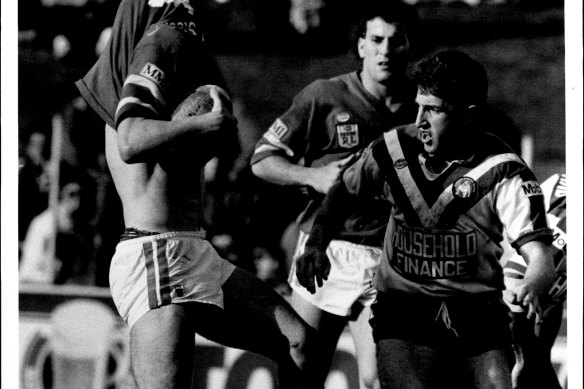
Jonathan Davies playing for the Bulldogs against Illawarra.Credit: Palani Mohan/Fairfax Media
“They were just re-building that year. Steven Folkes, Terry Lamb was there. It was a great experience for me to go down there. The pace of the game was just a different level. It was a great learning curve.”
Dog Days
There were major doubts the skinny Welshman would survive in the brutal world of Sydney rugby league but Davies’ class was obvious from the outset. After landing midweek in Sydney ahead of a round nine clash with Canberra, a late injury saw Davies start.
“I went straight into fullback, against Mal Meninga, Ricky Stuart, Bradley Clyde, Lazarus, Belcher, all those guys. We only just lost,” Davies said.
“The whole intensity of the training, the media coverage, the television. It was brilliant. It was brutal, there was a lot of fighting going on. But that was the highest competition I played in, I would say. I thouroughly enjoyed it.
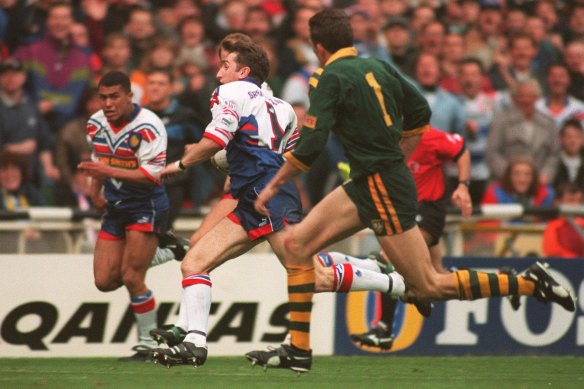
Jonathan Davies beats Brett Mullins to the line in a 1994 Test.Credit: Alamy Stock Photo
“I was very lucky, I played against Brett Kenny, Wally Lewis ... some of the great legends of the game. It was brilliant.”
Davies, who played fullback and some centre, only played 14 games for the Bulldogs in 1991, but he still managed to finish as the club’s top point scorer, with 100 points. Ewan McGrady won the Dally M medal that season and Davies’ speed and running lines had plenty to do with it.
“We had to beat Newcastle, and we had to beat Cronulla in the last two games to get in the playoffs. Bullfrog pulled me aside and said if you don’t pick your game up, we’ll have to put the under 20s (guy) in. I thought I was going well!” Davies said.
“But he got me, he pricked my ego and my pride, and so I scored against Newcastle and then two against Cronulla, up against Ettingshausen and McGaw.”
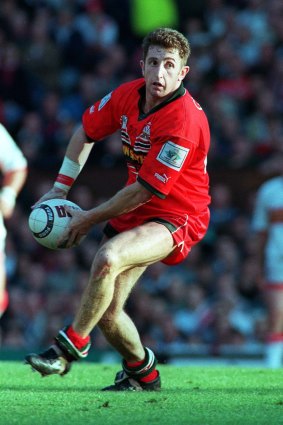
Jonathan Davies playing for Wales in the 1995 Rugby League World CupCredit: Action Photographics
The Bulldogs lost to Wests in a playoff for fifth spot, and Davies had to reluctantly turn down a three-year contract to stay because he’d signed an extension with Widnes.
“They went on to win it a few years later and Bullfrog sent me a lovely, lovely letter, saying your professionalism was part of our success,” Davies said.
Davies continued to star and was outstanding for Great Britain in an 8-4 win over the Kangaroos in 1994, burning Brad Clyde and Brett Mullins at Wembley. And after winning the Man of Steel award (given to the best player in English rugby league) while playing for Warrington in 1993-94, Davies had another short stint in Australia with the North Queensland Cowboys in 1995.
“It was a difficult period when the club were starting up and trying get a foothold, but I enjoyed my time with the Cowboys and I got to play against a young Andrew Johns,” he said. “In hindsight, I should probably have gone to Cronulla. Shane Richardson asked me to go there and I told him to get Allan Bateman instead.”
Rugby return
When rugby went professional in 1996, Davies returned to the 15-man game in Wales and played another two years of Test rugby before retiring. He has since become a beloved media figure in Wales and wider Britain.
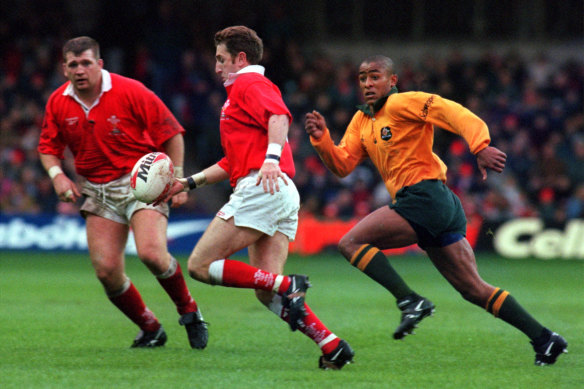
Jonathan Davies tries to beat a tackle by George Gregan in 1996.Credit: Alamy Stock Photo
“It was a great chance to understand rugby league and rugby union, in both continents. And to understand where they both sit, in both continents, really,” Davies said of his globe-crossing, code-hopping career.
On the surface, the games appear to be very similar, but in effect are more like third-cousins than siblings. It’s why many players who attempt to switch codes don’t make it, particularly when the transition is not handled well, says Davies.
“Overall, the decision-making is different. You have rucks and mauls, even a basic tackle is essentially a different thing in both game,” Davies said.
“The biggest thing for me was the instincts. My instincts, I would react quick in union because I knew where everything was on a pitch. But the instincts were different in league. It took me about three months to really, really get myself into it.
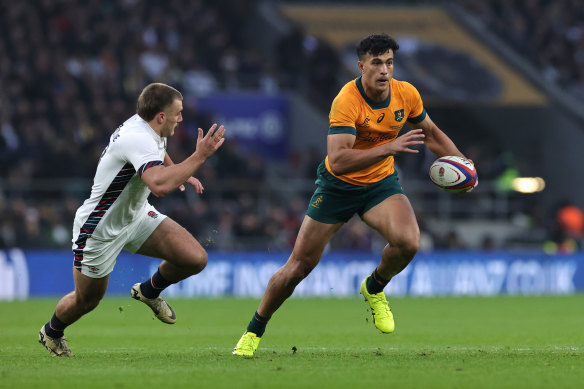
Joseph-Aukuso Suaalii running with the ball at Twickenham.Credit: Getty Images
“And same thing coming back into rugby, where it was technical again.”
It’s why Davies was so impressed by Suaalii, who nailed a handful of instinctive decisions.
Loading
“Australia utilised him well and played to his strengths,” he said.
“It’s only one game, and England didn’t expose him really, so maybe if you have Ireland or South Africa or New Zealand having a go at him, they’d say ‘hey we will try him, he might be a little bit naive’.
“But once Australia opened the game up, it worked out. He gets space, and he understands how to use the ball. And that’s instinctive. He had time and composure to put a try on. It was an excellent debut for him.
“He has all the attributes, he is a great athlete, great temperament, and he comes from a winning mindset at the Roosters. Australia has a wonderful player in Joseph.”



























